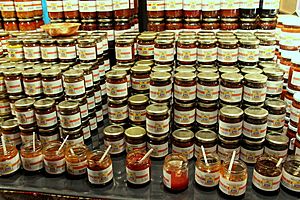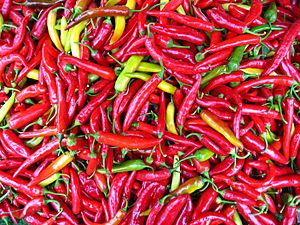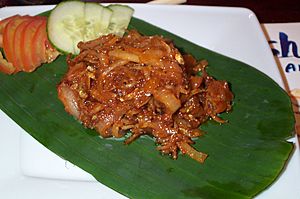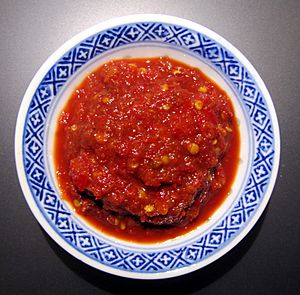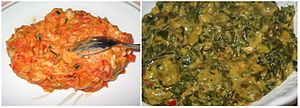Sambal facts for kids
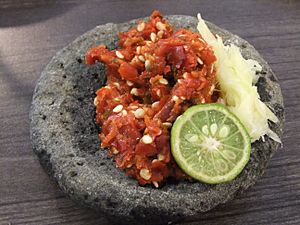
Traditional sambal terasi served on stone mortar with garlic and lime
|
|
| Course | Condiment or side dish |
|---|---|
| Region or state | Java |
| Serving temperature | Room temperature |
| Main ingredients | Ground chilli pepper with shallot, garlic and shrimp paste |
Sambal is a spicy sauce or paste. It is usually made from different kinds of chili peppers. Other ingredients like shrimp paste, garlic, ginger, shallot, palm sugar, and lime juice are often added. The word sambal comes from the Javanese and Sundanese languages in Indonesia.
Sambal started in Indonesia. It is now a big part of cooking in Malaysia, Sri Lanka, Brunei, and Singapore. People from Indonesia living in the Netherlands and Suriname also enjoy it. Sambal is often served as a hot and spicy side dish with meals. It goes well with grilled fish, fried chicken, and various soups. Indonesia alone has over 200 types of sambal! Most of these come from the island of Java.
Contents
The History of Sambal
Sambal is a famous spicy relish from Indonesia. It probably started in Java. This is because the word "sambal" comes from the Javanese word sambel. However, the main ingredient, the chili pepper, did not originally come from Southeast Asia. Chili peppers are from the Americas.
Chili peppers like Cayenne pepper and bird's eye chili came to Indonesia in the 1500s. Portuguese and Spanish sailors brought them during a time called the Columbian exchange. This was when plants, animals, and cultures were shared between the Americas and the rest of the world.
Before chili peppers arrived, people in Southeast Asia already used spicy ingredients. For example, a hot spice called cabya was popular in Java around the 900s. This cabya was actually a type of long pepper. Historians think it was used in early sambal-like sauces. Another spice used was ginger. Over time, chili peppers became super popular. They are now the main spicy ingredient in sambal.
Many different sambal recipes have been recorded over the years. An old Javanese book from the 1800s listed 16 types of sambal. A food researcher found over 200 types in Indonesia in 2017. Java has the most varieties, about 43 percent of them. Today, sambal is a must-have in homes across Southeast Asia.
How Sambal is Made
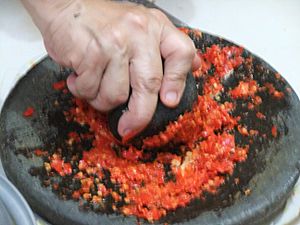
Traditional sambals are made fresh. People use a stone mortar called a cobek and a pestle called an ulekan. Sambal can be served raw or cooked. There are two main types in Indonesia: sambal masak (cooked) and sambal mentah (raw).
Cooked sambal has been heated. This gives it a special flavor and smell. Raw sambal is mixed with other ingredients and eaten right away. Cooked sambals are more common in western Indonesia. Raw sambals are popular in eastern Indonesia.
To make sambal, chili peppers, garlic, shallot, and tomato are often ground fresh. If terasi (shrimp paste) is used, it is usually fried or burned first. This gets rid of its strong smell and brings out its aroma.
Sambal can be made in large amounts. It can be stored in a sealed jar in the fridge for about a week. This makes it easy to serve with meals. However, some people like to make sambal fresh just before eating. This is called sambal dadak, meaning "freshly made sambal." In most local eateries, sambal is made daily in big batches.
Today, you can buy ready-made sambal in bottles or packets. These instant sambals often have a smoother texture. They are thicker, like tomato ketchup, because they are made by machines. Traditional sambals made with a mortar and pestle are usually coarser.
Some well-known brands that make bottled sambals include Huy Fong Foods' sambal oelek and Heinz ABC sambal terasi.
Types of Chili Peppers Used
Many different chili peppers are used to make sambal. Here are some common ones:
- Adyuma (also called habanero): This is a very spicy, yellow, block-shaped pepper.
- Cayenne pepper: A shiny, red, and long pepper.
- Madame Jeanette: A yellow-light green, long, and oddly shaped pepper.
- Bird's eye chili (called cabe rawit in Javanese): A very spicy, small, green-red pepper.
- Chili peppers (called lombok in Javanese): A milder, green-red, long pepper. Green ones are usually less spicy than red ones.
Sambal Varieties in Indonesia
Indonesia has hundreds of different sambal types. They range from mild to extremely hot. Here are a few popular ones:
- Sambal asam: This sambal is like sambal terasi but has tamarind added. Asam means tamarind or sour in Indonesian.
- Sambal balado: This is a style from the Minangkabau people. Chili pepper or green chili is blended with garlic, shallot, tomato, salt, and lime juice. Then it is cooked with oil. It is often mixed with other foods like egg or shrimp.
- Sambal bawang: This sambal is made from sliced shallots, chili pepper, garlic, shrimp paste, and lemon juice.
- Sambal buah: This means "fruit sambal." It is a specialty from Palembang. It is made from chili, shrimp paste, a type of mango called kemang, and pineapple.
- Sambal dabu-dabu: This sambal is from Manado. It is similar to Mexican salsa. It has chopped tomatoes, calamansi lime, shallots, and bird's eye chili. Hot oil is poured over it.
- Sambal durian or Sambal tempoyak: This sambal is made from fermented durian fruit called tempoyak. It can be raw or cooked. It has a sweet, sour, and hot taste.
- Sambal goreng: This means "fried sambal." It is made by stir-frying red shallots, red and green chili, shrimp paste, and salt in coconut oil. It can be made into a dish by adding ingredients like diced liver or small shrimp.
- Sambal ijo or Sambal lado mudo: This means "green sambal." It is a specialty from West Sumatra. It uses green chili, stir-fried with dried shrimp, red shallots, garlic, and spices. It is less hot than other sambals and has a fresh taste.
- Sambal matah: This is a raw sambal from Bali. It has lots of finely chopped shallots, bird's eye chili, lemongrass, cooking oil, and a bit of lime juice.
- Sambal petis: This sambal from East Java uses chili, petis (a type of shrimp paste), peanuts, and young banana.
- Sambal terasi: This is a very common Indonesian sambal. It is similar to Malaysian belacan but has a stronger flavor. It is made with red and green peppers, terasi, sugar, salt, and lemon or lime juice. It is often eaten raw.
- Sambal tomat: This sambal is like sambal tumis but with crushed tomato and sugar. It can be served fresh or cooked. It has a hot and sweet taste. For young children, it might be made with very little or no chili at all.
- Sambal ulek (or oelek): This is a raw chili paste. It is bright red, thin, and has a sharp taste. It can be used as a base for other sambals. The word ulek refers to the crushing and twisting motion used with a mortar and pestle.
Sambal Varieties in Malaysia
- Sambal belacan: This is a Malay style sambal. Fresh chilies are pounded with toasted shrimp paste (belacan), sugar, and lime juice. It can be eaten with cucumbers or leafy herbs.
- Sambal tempoyak: This sambal also uses fermented durian (tempoyak). It can be raw or cooked. The tempoyak has a sweet-sour taste that balances the chili's heat. It is common in Pahang and Perak.
- Sweet Sambal: This sambal is made from dried chilies, fresh chilies, belacan, and gula Melaka (palm sugar). It is traditionally served with nasi lemak, crispy anchovies, toasted peanuts, boiled egg, and cucumber.
Sambal Varieties in Sri Lanka
Sambals in Sri Lanka are different from those in Malaysia and Indonesia. They are usually made from uncooked ingredients. These include fresh chilies, shallots, coconut, and garlic. They are ground with a mortar and pestle and mixed with lime or lemon juice. They are similar to Mexican salsa.
- Seeni sambol: This is a hot and sweet sambal. It includes onion, crumbled Maldive fish, and spices. Its name comes from the local word for "sugar."
- Pol sambol: This sambal is made from scraped coconut, onion, green chili, red chili powder, and lime juice. Sometimes, crumbled Maldive fish is added.
- Lunumiris (Katta sambal): This is a red onion sambal. The name "lunu miris" means "salt chili." It is a paste of red chili pounded with sea salt. Katta sambal adds onions, crumbled Maldive fish, salt, and lime juice.
Dishes Using Sambal
Sambal can also be a main ingredient in a dish. In Padang cooking, dishes that start with balado- (meaning "with chili pepper") are sambal-mixed dishes. Here are some examples:
- Sambal cumi: This dish uses sambal mixed with squid or cuttlefish.
- Sambal goreng ati: This is a dish of fried liver mixed in sambal.
- Sambal daging: A Malay style sambal made from meat and spices. It is cooked for a long time until the meat breaks apart, similar to meat floss.
See also
 In Spanish: Sambal para niños
In Spanish: Sambal para niños


